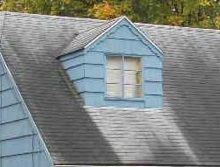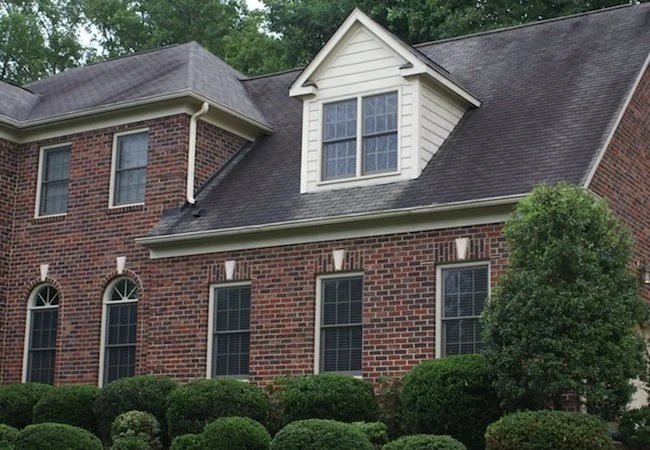We may earn revenue from the products available on this page and participate in affiliate programs. Learn More ›
It’s not mold. It’s probably not soot. The black spots discoloring your asphalt roof are more than likely the pervasive and prevalent algae known as Gloecapsa Magma. These roof-invaders require a moisture-rich environment, usually supplied by dew and shade. The first stains usually appear on the north-facing sides of a roof, which receives less light, and in areas with heavy tree coverage. Algae travels through the air, so if one neighbor receives a few spores, the whole neighborhood will soon be sporting the black streaks. Unfortunarly, they love to feed on the calcium carbonate contained in most asphalt shingles. According to Tom Bollnow of the Asphalt Roofing Manufacturers Association (ARMA), “The algae is mostly an aesthetic nuisance, although with time, the moisture retained in the algae can prematurely age the shingles.”
No matter how tempting, don’t attack the discoloration with a high-pressure washing system, which will affect the integrity of shingles. Instead, William Woodring, the Director of Technical Services at GAF, suggests gently spraying on a solution made from one cup of trisodium phosphate (available at most hardware stores), one gallon of bleach, and five gallons of water and letting it sit for about twenty minutes. “Apply the treatment on a cloudy day so the liquid doesn’t just evaporate,” says Woodring. Be sure to protect the plants and bushes that might be affected by the bleach runoff with plastic tarps. Then, rinse with a soft-pressure wash.

Of course, cleaning the roof doesn’t keep the mold from reoccurring. You might have noticed how the shingles near metal, like around skylights or chimneys with copper flashing, aren’t affected by the algae. That’s because the water running off contains minute traces of metal that stops its growth. A similar solution can be created by installing copper or zinc strips under the full course of shingles at the ridge of the roof. As rainwater washes across the metal it will create an uninhabitable environment for future spores.
Use strips that are six or seven inches wide and ten feet long, fastened with low profile, round-head ring-shank nails or screws made of compatible metal. Or, if starting from scratch is an option, re-shingle the roof with shingles that have metal granules to exact the same effect as the metal strips—manufacturers of algae-resistant shingles include Owens Corning, CertainTeed, and GAF. They cost a few dollars more per square foot, but ensure at least ten algae-free years.
If what you have are green stains, instead of black, then the culprit is moss, usually spread from overhanging trees. The solution is the same as with the algae, although a broom might be used to help gently dislodge the clingy spores. The same metal strips prevent the green vegetation from returning, but you can always help the process along by trimming overhanging trees and foliage away from the roof.
For more on roofing and seasonal maintenance, consider::
Asphalt Shingles 101
Quick Tip: Roof Repair or Replacement
Fall Home Maintenance Tips

